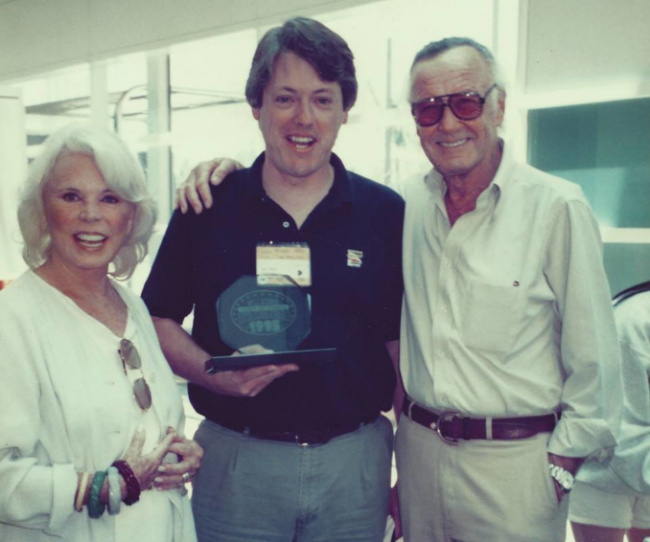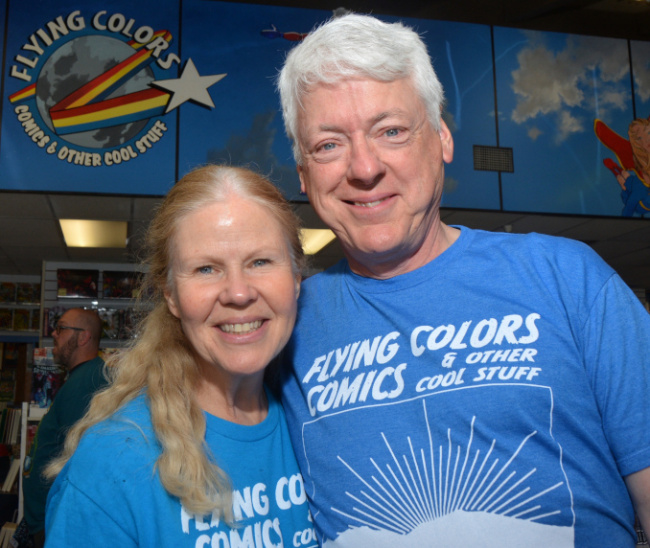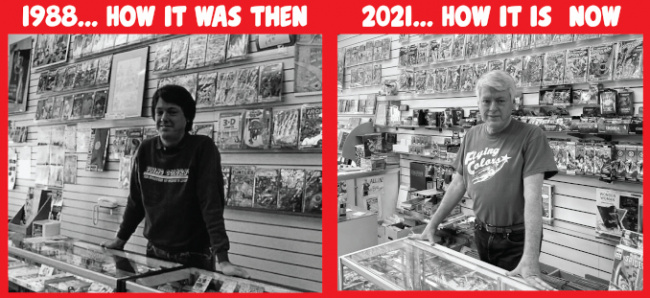It can be argued that you can’t tell the story of the Direct Market (or at least not a complete story) without Joe Field. We have radio, Stockton, California, and Stan Lee to blame.
Field was working in sales and marketing at KJOY AM in Stockton when Marvel Comics’ 25th anniversary rolled around in 1986. Always looking for a new promotion, Field, a longtime comic book fan, asked Marvel Comics to name Stockton the official birthplace of the Fantastic Four. “I was trying to fix a major continuity glitch as I saw it,” Field laughs these days.
Marvel agreed, or more to the point, another aggressive marketer named Stan Lee agreed. Stan came to Stockton, the locals were jazzed, and media from all across Northern California showed up to cover the event. Buoyed by his success, Field decided to try and turn “longtime comic book fan” into “comic book professional.” He interviewed with Bud Plant to be the company’s marketing director, and applied for sales positions with Marvel Comics, DC Comics, and Eclipse Comics. It… did not work out ideally.
“Pretty much all those interviews ended with, ‘You have no experience in publishing; you have no experience in comics. You have a good radio career going. Why do you even want to do this?'” Field says.
Field’s father-in-law was a successful businessman, and he set up some interviews with major ad agencies. “And they all ended with, ‘Kid, you gotta start in the mail room,'” Field relays. “So that wasn’t going to happen either.”

Image: Flying Colors Comics
Stan Lee with Joe Field, from the first time Stan visited Flying Colors in 1990.
What did happen, at long last, was Flying Colors Comics in Concord, California. Field figured no one could stop him from opening his own store. He did so on October 3, 1988, with $64 in business that day.
At the same time, Field was working on another aspect of “comic book professional” in the convention business. Mike Friedrich, a longtime comic writer and publisher, had been putting on small comic trade shows and creative conferences in Northern California. With a bevy of partners, Field included, he consolidated the disparate events into WonderCon in 1987. Friedrich knew of Field’s promotional ability, and the Stan Lee event.
“I met Joe, learned about his background in radio, and he’s a very likable guy,” Friedrich says. “I liked him right from the start.”
The 1987 WonderCon had about 10 partners. It proved… challenging.

Image: Oscar Benjamin
WonderCon management team, 1999. From left: Duncan Sandiland, Mike Friedrich, Joe Field, Ryan Liebowitz, Bryan Uhlenbrock.
“We had a very unwieldy committee,” Field says. “I remember meetings where we’d have a dozen people in a booth at a Denny’s trying to put things together, and it was just a mess. So naturally, there was a winnowing process. The people most involved with the actual con operations (selling booths, talent acquisition, paying the convention center) just kind of took the reins.”
Sure enough by 1988 and Year Two, WonderCon was down to just four principals, Friedrich and Field included. The convention prospered under their watch until they finally sold to Comic-Con International, the San Diego organization, in 2002 (see “Comic-Con International Takes Over WonderCon“). That’s when Field found he was his own worst enemy.
Flying Colors Comics was in a strip mall which also housed a Baskin-Robbins right next door. On Free Ice Cream Day, Field couldn’t help but note massive lines out the door at the ice cream shop and had the simple idea, “Why not for this, but for comics?”
“And Free Comic Book Day became the thing that immediately took over the time that WonderCon once did,” Field says. “But it felt important. I had that drive, to see if I could help create something that could help the whole industry.”
Field knew that cooperative efforts in comics were exceedingly difficult. But initial talks were aided, oddly enough, by massive outside forces.
“The meeting on Free Comic Book Day was also essentially the first industry-wide meeting after 9/11; the first flight for many people in publishing or distribution after that event,” Field says. “So there was a spirit of camaraderie that was there at the meeting that I don’t think has existed before or since. It was serendipitous timing. We had this terrible, horrible thing that happened in the world at large, but people felt like they had to come together and work together. And Free Comic Book Day, oddly, benefited from it.”
Jim Valentino, then the publisher of Image Comics, remembers the meeting well. Choosing the initial date for Free Comic Book Day (which eventually landed on May 4, 2002) was a bit of a bone of contention. Marvel’s first Spider-Man movie release date was May 3, 2002, and… what did we mention about cooperative efforts (see “Free Comic Book Day on May 4“)?
“I said, ‘Look guys, we have to do this together or not at all. If it was a DC movie, or a Dark Horse movie, we’d do it then. It’s a comic-based movie, and that’s what’s important,'” Valentino says today. “And the funny thing is, in years forward, movies started tying back in to Free Comic Book Day, something none of us could have imagined.”
Valentino also notes the importance of Field’s presence in the room.
“Joe is great until he starts talking about baseball, at which point my brain ticks off,” Valentino says. “But Joe is very cordial, a genuinely nice guy, a voice that unites. And there’s just not enough people like that.”
And the proof is in the pudding.
“It’s ‘free’ plus ‘comics.’ You can’t go wrong,” Valentino says. “For so many retailers, it’s become their biggest day of the year. Bottom line, it worked. And it worked for all the reasons Joe said it would. If you give people something for free, they’ll come into the store. And if they come into the store, they’ll buy.”
Flash forward to 2005, and Field found himself at the center of yet another Direct Market movement, the founding of retailer trade organization ComicsPRO, though he demurs on much acknowledgement there (see “A New Direct Market Comic Retailer Organization“).
“I can’t take much of the credit,” Field says. “Amanda Salmons, who runs Muse Comics and Games in Colorado Springs could pull together all the paperwork and that stuff, but she needed some of the well-known retailers in the business to serve as its founding board. She tapped me as the president, and brought in several other retailers.”
Despite the fact that comics had seen seemingly a million previous trade organizations, ComicsPRO looks like it has legs.
“What has always been the problem is that when the business goes South, that’s when retailers scatter,” Field says. “We kind of batten down our own hatches and fight our own battles rather than band together and fight the larger battle. If there’s one thing that’s worked for ComicsPRO it’s that it was started at a time when the market was relatively healthy. Early 2000s to just prior to the pandemic… it’s been pretty solid and consistent, if not super-great. But a pretty steady upward growth. That’s allowed ComicsPRO to be a steady group.”
And Mike Friedrich admires both Field’s leadership, and professionalism.

Image: Flying Colors Comics
Joe Field with Stan and Joan Lee after Field won the Eisner Spirit of Retailing Award.
“Joe had the enthusiasm most comic retailers have to sell comics; he loves comics,” Friedrich says. “But he also has the ability to step back and look at things professionally, see what the legit business factors are that he needs to succeed. He knows the importance of location, inventory control, order processes, all that stuff.
The only thing left to be carved out is the future for both Field and Flying Colors. Oddly, it’s unstable ground, and Field does not know which way he’s going to go.
“I have a lease that runs through January 2025. It’s been pulled out from under me,” he says. “I will not be in this space longer than that. So over the course of the next year, I have to figure out what the direction of this business is, where it goes, and what it looks like. I have all the big questions in front of me that I had prior to opening in 1988. Not a great place to be after 35 years.”
Field will make the people around him and the connections they’ve made a key part of his decision on how his business evolves.

Image: Flying Colors Comics
Joe and Libby Field, proprietors of Flying Colors Comics & Other Cool Stuff, Concord, California.
“I am not ready to give up on what we’ve built,” Field says. “And more than a store, we’ve built a nice community. That’s where comic shops have been so vital—we’ve built communities that bring something special to our local areas. I don’t want to give up on that. I want to keep Flying Colors vital for who knows how many years to come. But will that be with me at the helm 120% as it’s been in years past? Hopefully not. Hopefully I’ll find a way to be able to do this and not work 60 hours a week. But I understand the onus is on me to point the ship in the right direction.”
This article is part of ICv2‘s Direct Market 50th Anniversary project. For more on the history of the comics Direct Market, see “Comics Direct Market 50th Anniversary.”
Source: ICv2


